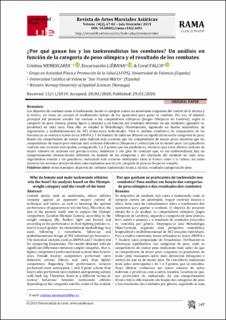| dc.contributor.author | Menescardi, Cristina | |
| dc.contributor.author | Liebana, Encarnación | |
| dc.contributor.author | Falco, Coral | |
| dc.date.accessioned | 2020-08-14T07:32:44Z | |
| dc.date.available | 2020-08-14T07:32:44Z | |
| dc.date.created | 2020-06-02T00:14:09Z | |
| dc.date.issued | 2020 | |
| dc.identifier.citation | Menescardi, C., Liébana, E., Falco, C. (2019). ¿Por qué ganan los y las taekwondistas los combates? Un análisis en función de la categoría de peso olímpica y el resultado de los combates. Revista de Artes Marciales Asiáticas, 14(2), 67-82. | en_US |
| dc.identifier.issn | 1885-8643 | |
| dc.identifier.uri | https://hdl.handle.net/11250/2671952 | |
| dc.description.abstract | Combat sports such as taekwondo, where athletes compete against an opponent require control of technique and tactics, as well as knowing the optimal performance of opponents to win the bout. Therefore, the aim of the present study was to analyse the Olympic competitors (London Olympic Games), according to the weight category (fly, feather, light and heavy) and according to the performance in their fighting (winner vs. loser) in each gender. An observational methodology was used, following a nomothetic, follow-up and multidimensional design of 302 individual performances. The statistical analysis used an ANOVA and T Student test for comparing frequencies. The results obtained indicate significant differences between weight categories, that is, lighter competitors performed more actions than heavier ones. Female heavier competitors performed more defensive actions (blocks and cuts) than lighter competitors. Regarding their performance, winners performed more anticipated, 1 and 3-point actions than losers who performed more indirect and spinning actions with back leg. Therefore, there is a different technicaltactical behaviour between taekwondo athletes depending on the categories and the result of the combat, suggesting to emulate winners, performing more anticipated actions to both trunk and head, as well as training the most used technical-tactical actions according to the athletes’ competition weight category. | en_US |
| dc.language.iso | spa | en_US |
| dc.publisher | Universidad de León | en_US |
| dc.rights | Navngivelse-Ikkekommersiell-DelPåSammeVilkår 4.0 Internasjonal | * |
| dc.rights.uri | http://creativecommons.org/licenses/by-nc-sa/4.0/deed.no | * |
| dc.subject | martial arts | en_US |
| dc.subject | combat sports | en_US |
| dc.subject | taekwondo | en_US |
| dc.subject | techniques | en_US |
| dc.subject | tactics | en_US |
| dc.subject | result | en_US |
| dc.subject | weight categories | en_US |
| dc.title | Why do female and male taekwondo athletes win the bout? An analysis based on the Olympic weight category and the result of the bout. | en_US |
| dc.type | Journal article | en_US |
| dc.description.version | publishedVersion | en_US |
| dc.rights.holder | © 2019 | 67 Universidad de León | en_US |
| dc.source.pagenumber | 67-82 | en_US |
| dc.source.volume | 14 | en_US |
| dc.source.journal | Revista de Artes Marciales Asiáticas | en_US |
| dc.source.issue | 2 | en_US |
| dc.identifier.doi | 10.18002/rama.v14i2.6051 | |
| dc.identifier.cristin | 1813391 | |
| cristin.ispublished | true | |
| cristin.fulltext | original | |

